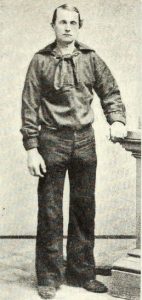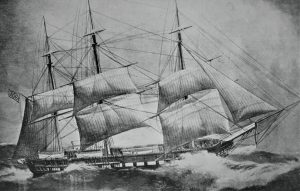Under Fire — Feeling Something Warm: A Gunner on USS Congress in the Battle of Hampton Roads

The fearsome Rebel ironclad CSS Virginia (ex USS Merrimack, aka Merrimac) materialized in Hampton Roads, Virginia, that calm and clear Saturday morning, March 8, 1862. “The ‘Merrimac’ was steaming slowly towards us,” recalled Seaman Frederick H. Curtis of the wooden sailing frigate USS Congress, “and every eye on the vessel was on her. Not a word was spoken, and the silence that prevailed was awful. The time seemed hours before she reached us.”
Congress (480 men, 52 guns) and the sailing sloop-of-war Cumberland (400 men, 24 guns) swung lazily at anchor opposite Federal batteries on Newport News Point blocking the James River and waterborne access to the Confederate capital. Steam frigates Minnesota and Roanoke (550 men, 40 guns each)—the most powerful warships in the U. S. Navy—lay a few miles away with other fleet units under the protection of Fort Monroe. As spring of 1862 opened, all assumed that Virginia would emerge from Gosport Shipyard to destroy and drive away the blockaders. The Union had no ironclads to oppose her.

Young Frederick Curtis, a native of Hanover, Massachusetts, enlisted at the Charlestown Navy Yard. After few months blockading Wilmington, North Carolina, he transferred to Congress, which had just returned from several years’ service on the South American station. This was his first battle.
Virginia (250 men, 10 guns, and a ram) chugged up within 100 yards of Congress and opened fire. Seaman Curtis: “All I remember about that broadside was of feeling something warm, and the next instant I found myself lying on the deck beside a number of my shipmates. I was captain of No. 8 gun, and a shell from the ‘Merrimac’ came into the porthole of gun No. 7, striking the gun carriage, dismounting the gun, and sweeping the men about it back into a heap, bruised and bleeding. The shell struck right back of me and took my left-hand man.”

Congress managed to get off a few shots as the enemy ironclad slid by. Then, continued Curtis, “[Virginia] ran into the ‘Cumberland’ with her long iron nose and struck her in her starboard side.” Meanwhile, Rebel gunboats Patrick Henry, Yorktown, and Jamestown charged downriver and began to pelt the two Union ships at long range. “Their shots failed to do much damage, but we returned their fire and got a shell into the boiler of one of them, and she blew up.”
Minnesota and Roanoke upped anchor and began struggling upstream to join the fight assisted by steam tugs, but Minnesota ran her deep hull aground in the shoals while Roanoke, afraid of the same fate, reversed course and returned to the fort. The immobile Minnesota began shelling Virginia at too long a range to be effective.
Curtis: “We had succeeded in swinging the ‘Congress’ around broadside with the ‘Merrimac,’ and kept up a steady fire at her. Our shots, however, did her little damage. They would strike her and glance off into the water beyond.” Cumberland sank rapidly while the crew piled into boats, jumped in to swim ashore, and climbed the rigging. “The rebels did not attempt to trouble them; but out of a crew of about four hundred only about half of them survived.”

“We were kept pretty busy shelling the ‘Merrimac,’ and after she had destroyed the ‘Cumberland’ she turned her attention to us.” A Rebel shell exploded in the wardroom, setting Congress ablaze very near the powder magazine. Crewmen set pumps to work flooding the magazine and fighting the fire.
“It was a pretty busy time aboard just then, and the men were much excited. Our little powder boy, a lad of only thirteen years of age, would bring us ammunition, with the tears streaming down his cheeks. He had pure grit and stuck to his duties like a man. The order was then passed for us to cease firing, and our colors were struck. My gun was loaded at the time, and, although the order had been given to cease firing, I pulled the lanyard and fired what proved to be the last shot ever fired on board the fated ‘Congress.’”

Gloom settled over the ship, wrote Curtis, when they learned their commanding officer, Lieutenant Joseph B. Smith, had been killed. “We then began to pay attention to the wounded who were lying about the decks. With the assistance of one of my shipmates, I picked up one of the men of my gun who had his foot shot off, and carried him below. His wounds were fatal, and he died soon after. The sight in the cockpit was an awful one. Wounded and dead were lying all around, and cries of anguish filled the air.”
They began to abandon Congress. “One of my shipmates, Jesse H. Jewett, came rushing through the [gun]port and swung himself out and hung on by his hands. He had been fighting the fire below, and his hair was singed from his head and his back was badly burned.” Curtis hailed a nearby boat and begged them to take Jewett aboard, which they did. But “his injuries were fatal, and I helped bury him in the sand the next day.” Rebels began firing muskets at them. “The coxswain of one of the boats stood up in the stern sheets and waved his hands at them derisively, for which act he was heartily cheered by those on board the ‘Congress.’”
The Confederate gunboat Beaufort surged alongside; an officer clambered aboard with an armed party to remove the crew of Congress and destroy the ship. Curtis: “Some of the rebels acted like crazy men and would drive our men about like cattle. They became so abusive that one of our men, a darky, shot one of them. I did not think much of such treatment, and went below.” The young seaman thought the Rebel officer a brave man. “He was smoking a cigar and seemed to be very cool. When he saw what havoc the shots from the ‘Merrimac’ had done on board, he said: ‘My God, this is terrible. I wish this war was over.’”

Union artillery and sharpshooters ashore concentrated on Beaufort, killing several Confederates along with some of their own, and forcing the gunboat to pull back. Virginia retaliated with hot shot into the already burning ship. Returning to his station, Curtis found a rope hanging out of the gunport.
“I swung myself out and dropped into the water. I sank well under, and on rising to the surface picked up my hat and started for the shore. The water about me was filled with men. Keeping as far away from them as possible, I started for the shore nearly half a mile away. I soon found that I had undertaken quite a job and that if I hurried I would surely become exhausted and drown. I saw several of my comrades drown, but was powerless to help them. In time I reached the shore, but on leaving the water I was so weak that I was hardly able to stand.”
“The shells from the ‘Merrimac’ were flying over my head, and I started for the soldiers’ camp in the distance, where I found several of my comrades.” One shell passed so near he felt the wind. Another Rebel round passed right through the hospital, struck the sand, and buried one of his shipmates who had been helping man the shore guns. “He was not hurt, but was pretty thoroughly frightened.”
It was nearly dark. Curtis and crewmates decided to reboard Congress, recover clothing, and help wounded ashore. Dodging grapeshot, they found a boat and started back “keeping as much out of sight of the ‘Merrimac’ as possible.” Firing subsided as Virginia withdrew toward Norfolk. “We were not sorry to see the rebel ram depart, but we all expected to see her back the next day to complete the destruction of the fleet.”
Finding about twenty men and a few officers still on the ship, they loaded the captain’s body and wounded into the boat. Curtis descended to the gundeck for his clothing and “a little box.” He thought the fire had been put out, but the wardroom still burned.
“The smoke was so thick and stifling below decks that it was almost impossible to see anything; but with the aid of the cook, a little Irishman, who had a small piece of candle, we managed to get our belongings, and returned to the spar deck.” Someone suggested they attempt to extinguish the fire, but Curtis convinced them it was useless; they would only suffocate.
The boat returned to shore where soldiers welcomed them for the night. “I went with a party of the 5th Indiana, and shall never forget their kindness to us poor stranded sailors. Late in the night we were all awakened by a loud explosion, which was found to be the forward magazine of the ‘Congress.’ The fated vessel was soon a mass of flames, and it was with feelings of sorrow that we saw her burn to the water’s edge.”
Seaman Curtis did not see the USS Monitor enter the roads that night. The next morning, he would watch from the top of a tree as Monitor stopped Virginia from further destruction. “All on shore cheered the brave little ‘Monitor’ until they were hoarse, and many hugged one another for joy to know that the hated rebel ram was whipped. So closed two of the most anxious and thrilling days of my experience in the war.”
Curtis was reassigned to another ship where he participated in Burnside’s North Carolina expedition and the Seven Day’s Campaign. “We assisted the army every day and saw some pretty hard fighting.”
Source: Frank Stedman Alger, “The ‘Congress’ and the ‘Merrimac.’ The Story Of Frederick H. Curtis, A Gunner On the ‘Congress,’” The New England magazine 19 (February 1899), 687.
Adapted from: Dwight Sturtevant Hughes, Unlike Anything That Ever Floated: The Monitor and Virginia and the Battle Hampton Roads, March 8-9, 1862 (Savas Beatie, 2021).

Thank you for this. Great stuff.
thanks Dwight … when i lived in Hampton, VA in the early 80’s, our house was in a section called Merrimac Shores (right on the water) … the streets in the development — built in the early 50’s — were all named for ships and persons in the the battle … we lived on Catesby Jones Drive … Congress Ave was one street over … great post … many thanks.